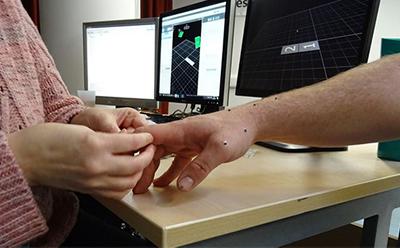
Life at the Cutting Edge
Project contacts:
- Dr Christian Steven Hoggard, University of Southampton and Aarhus University
- Dr Cory M Stade, Centre for the Archaeology of Human Origins (CAHO), University of Southampton
Partners:
Winchester School of Art
Engagement activitity:
- Participation in the UoS Science and Engineering and Human Worlds Festivals
- Events with the Young Archaeologist’s Cluband and the UoS Department of Archaeology’s ‘Archaeovillage’
- An experiment using a porcelain replica of a blade
Project summary:
The ‘Life at the Cutting Edge’ project was designed to integrate and engage with the public directly, to answer a central question within human origins research: how can archaeologists recognise skill and expertise within early prehistory, and specifically with the use-wear on artefacts that past societies used? Through an experiment integrating use-wear and motion capture analyses, three questions were proposed: Can differing levels of dexterity be identified during scraping activities? To what extent can knowledge transmission be identified from the tools utilised by participants? To what extent do wear patterns on porcelain replica tools correspond to experiments using flint? Each of these questions, assessed in controlled laboratory settings and protocol, benefit from wider public participation, and greater interdisciplinary investigation. Throughout the duration of the award, the team actively pursued engagement with the wider community wherever possible.
Key outcomes:
The project helped to promote and enhance a culture of public engagement with research within the University. Experimental archaeology has enormous potential to engage people with how archaeologists can test potential explanations for patterns seen in the archaeological record, as well as how it can draw upon, and contribute to, other disciplines. Attendees to our stalls were intrigued by what it was we do in experimental archaeology, and were impressed by how we could use it within an empirical framework. Children and young people were also able to see ‘science in action’, and understand exactly why we weren’t just peeling potatoes with porcelain for no scientific aim. This is perhaps best exemplified by the Young Archaeologists Club event, where children were engaged in ‘hands on’ activities, using microscopes, to understand what archaeologists can see on a magnified level, and the effect of use on tools.
What's next:
The project can be sustained both (1) short-term, through further dissemination and communication of the project, and given the structures already in place (dialogue with the public through Facebook, Twitter and Reddit, for example), and (2) long-term - with further academic publication output. In sustaining the project over the long-term, a British Academy / Leverhulme Small Award application is currently being drafted, with potential for postdoctoral research for two of the members on the project.